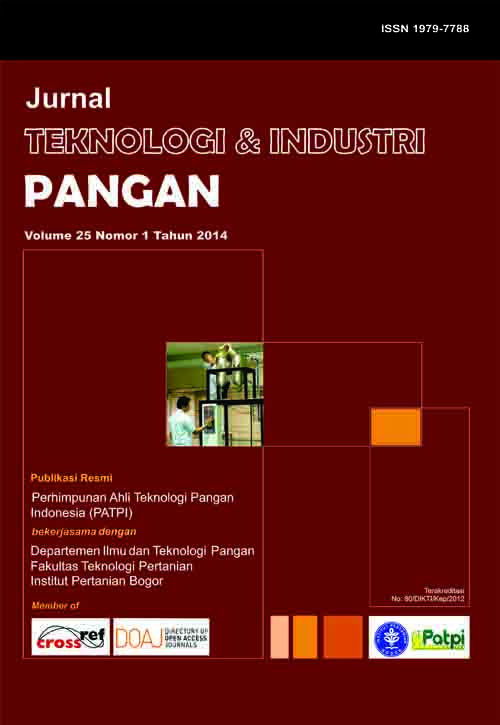PEMANFAATAN BAKTERI PROBIOTIK INDIGENUS DALAM PEMBUATAN KEJU LUNAK [Utilization of Indigenous Probiotic Bacteria in the Production of Soft Cheese]
Abstract
PEMANFAATAN BAKTERI PROBIOTIK INDIGENUS DALAM PEMBUATAN KEJU LUNAK
[Utilization of Indigenous Probiotic Bacteria in the Production of Soft Cheese]
Fifi Afiati1)*, Yopi1) dan Rarah R.A. Maheswari2)
1) Pusat Penelitian Bioteknologi LIPI, Jl. Raya Bogor Km 46, Cibinong, Bogor
2) Departemen Ilmu dan Teknologi Peternakan, Fakultas Peternakan, Institut Pertanian Bogor, Bogor
Diterima 12 April 2013 / Disetujui 15 Februari 2014
ABSTRACT
Probiotic soft cheese containing lactic acid bacteria is one of functional food products. Three lactic acid bacteria namely Lactococcus lactis DSB 42 (LL-DSB42), Lactobacillus acidophilus RRM-01 (LA-RRM01) and Bifidobacterium longum RRM-01 (BL-RRM01) were used in the production of probiotic soft cheeses. Single culture (BL, LA, and LL) and mixed culture (BL-LA, BL-LL, LA-LL and BL-LA-LL) were used to produce diversified functional products. The preparation of probiotic soft cheese consists of pasteurization, addition of lactic acid bacterial culture (5%, v/v), addition of rennet, cutting the curd, scalding, draining and packaging. Soft cheese characteristics were analyzed physically (yield), chemically (pH, water content, crude protein, crude fat and ash) and microbiologically (lactic acid bacteria). The results showed that addition of lactic acid bacteria cultures significantly decreased the pH value (pH 5.10 to 5.79). The yield of probiotic soft cheese produced was in the range of 17.86-22.51% with water content of more than 55%. The fat and carbohydrate content of both cheeses of single and mixed cultures were significantly different (p<0.05) (fat content 5.1-7.4% for single culture and 4.0-9.3% for mix culture; carbohydrate content 11.6-17.7% for single culture and 4.6-12-2% for mix culture). The combination of all three starter cultures did not result in inhibition to each other, thus these combination were able to achieve the maximum number of 9.0 log10CFU g-1 on a single culture soft cheese and 9.8 log10CFU g-1 in mixed cultures soft cheese. In conclusion, soft cheeses with single culture (BL, LA, and LL) and mixed culture (BL-LA, BL-LL, LA-LL and BL-LA-LL) had excellent potential properties to be developed as probiotic foods.

